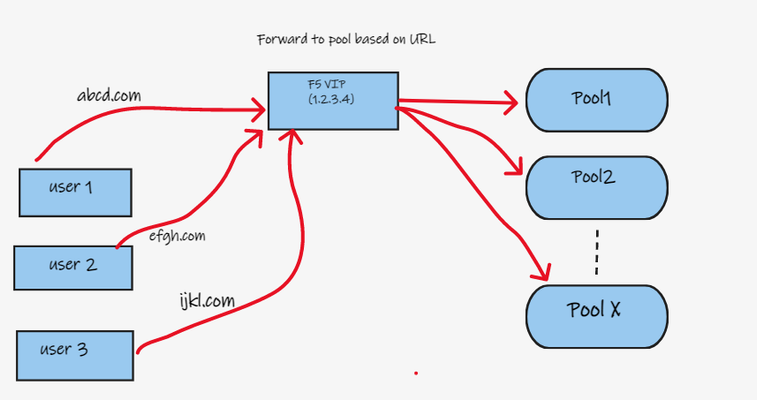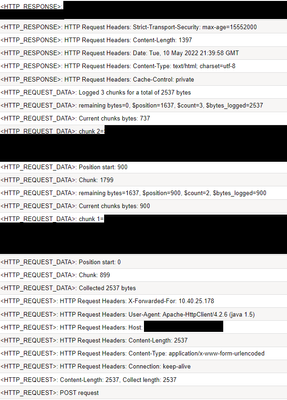irule
677 TopicsAutomate Let's Encrypt Certificates on BIG-IP
To quote the evil emperor Zurg: "We meet again, for the last time!" It's hard to believe it's been six years since my first rodeo with Let's Encrypt and BIG-IP, but (uncompromised) timestamps don't lie. And maybe this won't be my last look at Let's Encrypt, but it will likely be the last time I do so as a standalone effort, which I'll come back to at the end of this article. The first project was a compilation of shell scripts and python scripts and config files and well, this is no different. But it's all updated to meet the acme protocol version requirements for Let's Encrypt. Here's a quick table to connect all the dots: Description What's Out What's In acme client letsencrypt.sh dehydrated python library f5-common-python bigrest BIG-IP functionality creating the SSL profile utilizing an iRule for the HTTP challenge The f5-common-python library has not been maintained or enhanced for at least a year now, and I have an affinity for the good work Leo did with bigrest and I enjoy using it. I opted not to carry the SSL profile configuration forward because that functionality is more app-specific than the certificates themselves. And finally, whereas my initial project used the DNS challenge with the name.com API, in this proof of concept I chose to use an iRule on the BIG-IP to serve the challenge for Let's Encrypt to perform validation against. Whereas my solution is new, the way Let's Encrypt works has not changed, so I've carried forward the process from my previous article that I've now archived. I'll defer to their how it works page for details, but basically the steps are: Define a list of domains you want to secure Your client reaches out to the Let’s Encrypt servers to initiate a challenge for those domains. The servers will issue an http or dns challenge based on your request You need to place a file on your web server or a txt record in the dns zone file with that challenge information The servers will validate your challenge information and notify you You will clean up your challenge files or txt records The servers will issue the certificate and certificate chain to you You now have the key, cert, and chain, and can deploy to your web servers or in our case, to the BIG-IP Before kicking off a validation and generation event, the client registers your account based on your settings in the config file. The files in this project are as follows: /etc/dehydrated/config # Dehydrated configuration file /etc/dehydrated/domains.txt # Domains to sign and generate certs for /etc/dehydrated/dehydrated # acme client /etc/dehydrated/challenge.irule # iRule configured and deployed to BIG-IP by the hook script /etc/dehydrated/hook_script.py # Python script called by dehydrated for special steps in the cert generation process # Environment Variables export F5_HOST=x.x.x.x export F5_USER=admin export F5_PASS=admin You add your domains to the domains.txt file (more work likely if signing a lot of domains, I tested the one I have access to). The dehydrated client, of course is required, and then the hook script that dehydrated interacts with to deploy challenges and certificates. I aptly named that hook_script.py. For my hook, I'm deploying a challenge iRule to be applied only during the challenge; it is modified each time specific to the challenge supplied from the Let's Encrypt service and is cleaned up after the challenge is tested. And finally, there are a few environment variables I set so the information is not in text files. You could also move these into a credential vault. So to recap, you first register your client, then you can kick off a challenge to generate and deploy certificates. On the client side, it looks like this: ./dehydrated --register --accept-terms ./dehydrated -c Now, for testing, make sure you use the Let's Encrypt staging service instead of production. And since I want to force action every request while testing, I run the second command a little differently: ./dehydrated -c --force --force-validation Depicted graphically, here are the moving parts for the http challenge issued by Let's Encrypt at the request of the dehydrated client, deployed to the F5 BIG-IP, and validated by the Let's Encrypt servers. The Let's Encrypt servers then generate and return certs to the dehydrated client, which then, via the hook script, deploys the certs and keys to the F5 BIG-IP to complete the process. And here's the output of the dehydrated client and hook script in action from the CLI: # ./dehydrated -c --force --force-validation # INFO: Using main config file /etc/dehydrated/config Processing example.com + Checking expire date of existing cert... + Valid till Jun 20 02:03:26 2022 GMT (Longer than 30 days). Ignoring because renew was forced! + Signing domains... + Generating private key... + Generating signing request... + Requesting new certificate order from CA... + Received 1 authorizations URLs from the CA + Handling authorization for example.com + A valid authorization has been found but will be ignored + 1 pending challenge(s) + Deploying challenge tokens... + (hook) Deploying Challenge + (hook) Challenge rule added to virtual. + Responding to challenge for example.com authorization... + Challenge is valid! + Cleaning challenge tokens... + (hook) Cleaning Challenge + (hook) Challenge rule removed from virtual. + Requesting certificate... + Checking certificate... + Done! + Creating fullchain.pem... + (hook) Deploying Certs + (hook) Existing Cert/Key updated in transaction. + Done! This results in a deployed certificate/key pair on the F5 BIG-IP, and is modified in a transaction for future updates. This proof of concept is on github in the f5devcentral org if you'd like to take a look. Before closing, however, I'd like to mention a couple things: This is an update to an existing solution from years ago. It works, but probably isn't the best way to automate today if you're just getting started and have already started pursuing a more modern approach to automation. A better path would be something like Ansible. On that note, there are several solutions you can take a look at, posted below in resources. Resources https://github.com/EquateTechnologies/dehydrated-bigip-ansible https://github.com/f5devcentral/ansible-bigip-letsencrypt-http01 https://github.com/s-archer/acme-ansible-f5 https://github.com/s-archer/terraform-modular/tree/master/lets_encrypt_module (Terraform instead of Ansible) https://community.f5.com/t5/technical-forum/let-s-encrypt-with-cloudflare-dns-and-f5-rest-api/m-p/292943 (Similar solution to mine, only slightly more robust with OCSP stapling, the DNS instead of HTTP challenge, and with bash instead of python)29KViews6likes19CommentsHelp with iRule logging to local0.
I am trying to log an iRule, but it keeps erroring out. Can you help with what I'm missing? when HTTP_REQUEST { if { [HTTP::path] starts_with "/media" } { pool persist cookie insert log local0. ”media.com_28080 TCP_logging fired, from [IP::client_addr]" } }8.1KViews0likes9CommentsiRule to Forward Traffic Based on URL Name
Hi, I am in a situation where we have shortage of IP address and am looking for an alternative way to forward traffic to pools based on URL. I am not really good with iRule hence looking for assistance and I have seen posts based on URI, but i am looking for assistance with URL. Eg: 1 VIP and based on the url name, the traffic needs to be forwarded to Pool. Help on this is appreciatedSolved3.8KViews0likes10CommentsBIG-IP : iRule test that variable exists and has certain value
F5 BIG-IP Virtual Edition v11.4.1 (Build 635.0) LTM on ESXi What is the simplest most elegant syntax to test that a variable exists and has a certain value ? For example if I want to determine that myvariable exists and has non-zero value , is this the simplest syntax ? when HTTP_REQUEST { set myvariable 0 conditional processing ... set myvariable 1 more processing ... if {[info exists $myvariable] && [$myvariable]} { do something }3.7KViews0likes2CommentsiRule to decrypt and rewrite RADIUS User-Password AVP
In the RADIUS protocol, the user's cleartext password is transmitted inside Attribute-Value Pair (AVP) 2, padded with null characters as necessary, and then encrypted by the shared secret by XOR'ing it across the authenticator somehow or other. The technical details of how this works is a bit above my level of understanding as I'm not a cryptography expert. We have an infrastructure where our PAN VPN Gateway prompts a user for their username and password. In our environment, after the password, the user appends a fixed-length HOTP token from a Yubikey. The backend FreeRADIUS server has been configured to decrypt the password received, extract the fixed-length token, and perform backend checks to our LDAP and token servers. FYI, the password is encoded as PAP prior to RADIUS encryption in our setup, which is why this works; CHAP would prevent this from working. We've been having trouble with the stability of our FreeRADIUS server and we would like to leverage our much more stable Aruba ClearPass infrastructure which is load balanced globally with our GTMs and LTMs and highly stable. This also moves control of the RADIUS piece away from the systems team and onto the network team (me, specifically). Unfortunately, ClearPass doesn't have a direct mechanism to break the password from the token, and PAN doesn't have a way to transmit the token separately. This is where we would like to leverage an iRule. Basically, the way I envision this working is as such: Decrypt the password+OTP that is received from PAN using the authenticator value and shared secret Rewrite AVP 2 as just the password, encrypted by the shared secret (make sure to adjust the length of the AVP) Insert AVP 17 (which is not defined by the IEFT) with the token (ClearPass can be configured to look for this by modifying its RADIUS dictionary). Rewrite the length value at layer 7 if necessary - not sure if this would happen automatically by the F5; probably not. Ship the modified RADIUS packet to ClearPass I know how to accomplish all of this on the ClearPass side, but my dev skills are weak, I'm not very familiary with Tcl, and I don't have a solid understanding of how to encrypt/decrypt the password correctly. I've search high and low but the only solutions for decrypting the password seem to be written in languages that are even more difficult to understand like C. I obviously understand it is too much to expect someone to write the entire solution for me, but any advice on where to start would be very helpful. I think the trickiest part for me would be the encrypt/decrypt step.Solved3.7KViews0likes21CommentsiRule [string range...] not chunking data properly
I have an irule (much of which I found here) that is to gather some much needed troubleshooting data I need in regards to the headers and payload I have coming in. The payload is obvisouly too large for a single log line so this was supposed to chunk it into manageable bytes. I had to make some modifications to the original irule which did not work, but now it is working, sort of. It logs the first 900 bytes as it should, then something happens and skips a bunch, and then logs the final bytes of data. I can't understand why it's not grabbing either the proper amount of data or failing to output this second chunk of missing data before making its final loop. iRule is here: when RULE_INIT { # Log debug to /var/log/ltm? 1=yes, 0=no set static::payload_dbg 1 # Limit payload collection to 5Mb set static::max_collect_len 5368709 # Max characters to log locally (must be less than 1024 bytes) # https://clouddocs.f5.com/api/irules/log.html set static::max_chars 900 set static::min_chars 0 } when HTTP_REQUEST { # Only collect POST request payloads if {[HTTP::method] equals "POST"}{ if {$static::payload_dbg}{log local0. "POST request"} # Get the content length so we can request the data to be processed in the HTTP_REQUEST_DATA event. if {[HTTP::header exists "Content-Length"]}{ set content_length [HTTP::header "Content-Length"] } else { set content_length 0 } # content_length of 0 indicates chunked data (of unknown size) if {$content_length > 0 && $content_length < $static::max_collect_len}{ set collect_length $content_length } else { set collect_length $static::max_collect_len } if {$static::payload_dbg}{log local0. "Content-Length: $content_length, Collect length: $collect_length"} foreach aHeader [HTTP::header names] { log local0. "HTTP Request Headers: $aHeader: [HTTP::header value $aHeader]" } #set payload [HTTP::collect $collect_length] HTTP::collect $collect_length } } when HTTP_REQUEST_DATA { # Log the bytes collected if {$static::payload_dbg}{log local0. "Collected [HTTP::payload length] bytes"} # Log the payload locally if {[HTTP::payload length] < $static::max_chars}{ log local0. "Payload=[HTTP::payload]" } else { # Initialize variables set remaining [HTTP::payload] set position 0 set count 1 set bytes_logged 0 # Loop through and log each chunk of the payload while {[string length $remaining] > $static::min_chars}{ #chunk = 899 set chunk [expr {$position + $static::max_chars -1}] log local0. "Chunk: $chunk" log local0. "Position start: $position" # Get the current chunk to log (subtract 1 from the end as string range is 0 indexed) set current [string range $remaining $position $chunk] log local0. "chunk $count=$current" log local0. "Current chunks bytes: [string length $current]" # Add the length of the current chunk to the position for the next chunk incr position [string length $current] # Get the next chunk to log set remaining [string range $remaining $position end] incr count incr bytes_logged $position log local0. "remaining bytes=[string length $remaining], \$position=$position, \$count=$count, \$bytes_logged=$bytes_logged" } if {[string length $remaining]}{ log local0. "chunk $count=$current" incr bytes_logged [string length $remaining] } log local0. "Logged $count chunks for a total of $bytes_logged bytes" } } when HTTP_RESPONSE { foreach aHeader [HTTP::header names] { log local0. "HTTP Request Headers: $aHeader: [HTTP::header value $aHeader]" } } The image below shows what I'm talking about - it even says "Oh I found 3 chunks", but I'm only being presented 2. I added some logging around the position, chunk value (aka end position), and bytes logged to help illustrate that it's clearly skipping over something. Any help would be appreciated! ThanksSolved3.2KViews0likes6CommentsHow can I preserve the original HTTP Host Header to the Backendservers?
Hi guys, I'm trying the following configuration to loadbalance a RH SSO Key cloack Cluster: clientIP -> https/443 -> (clientssl-Profile) F5-Virtual Server (serverssl-Profile) -> SNAT-IP -> tcp8443 -> Backendserver The Backendserver need to see the original client http Header, so I created a http Profile with the "Insert X-Forwarded-For"-Option enabled. Alternative I tried the following iRule: when HTTP_REQUEST { HTTP::header insert X-Forwarded-For [IP::client_addr] } Unfortunaly, both ways didn't work properly... How can I preserve the whole original HTTP Host Header trough the F5 to the Backendservers? Thank you!3.1KViews0likes3CommentsRequest client cert auth based on URL
I am trying to request client cert authentication based on select URL and it works with a whitelist only but when i use the negate in the datagroup with a datagroup including URI string values it does not work. Sounds perhaps weird but it seems that negating the datagroup with URI entries is not working properly. So when using a whitelist which should be bypassed it works and other websites are authenticated succesfully and a client certificate is being requested. In the client SSL profile we dont use the client cert authentication because we dont want the client cert authentication to be performed for all URLs, hence the SSL::renegotiate option. This seems to do the trick however while negating (not) against a list of websites that should use cert auth does not work and currently dont have the explenation for this behavior. We only have a list of websites that is using cert auth and not a full list of other websites that shouldnt use cert auth, therefor negating the websites would be the easiest solution. Is there any limitation with negating a datagroup with string values? Another side question is that we would like to perform the SSL::renegotiate and request a specific client cert from a certain CA issuer, how could we accomplish that? when HTTP_REQUEST { if {not[class match [string tolower [HTTP::uri]] contains DG_ACC_NO_CERT_AUTH] }{ #HTTP::header insert SSL_CLIENT_CERT [b64encode [SSL::cert 0]] log local0. "certificate not inserted and header SSL_CLIENT_CERT value is: [HTTP::header value SSL_CLIENT_CERT] for host [HTTP::host] and URI: [HTTP::uri]" } else { SSL::session invalidate SSL::authenticate always SSL::authenticate depth 9 SSL::cert mode request SSL::renegotiate enable SSL::renegotiate HTTP::header insert SSL_CLIENT_CERT [b64encode [SSL::cert 0]] log local0. "certificate inserted and header SSL_CLIENT_CERT value is: [HTTP::header value SSL_CLIENT_CERT] for host [HTTP::host] and URI: [HTTP::uri]" } }Solved3KViews0likes14CommentsNeed iRule to block the traffic for specific URL
Hello Can somebody help on this please? I have LTM appliance & Virtual server 'https://www100.test.com' hosted. The requirement I have is to block all the traffic destinated to one of the application 'https://www100.test.com/ce' - is this something achievable by iRule If so do you have any idea on the iRule? Would appreciate somebody can help. Have seen this - https://support.f5.com/csp/article/K74012450 but that is looking too complex to me. Thanks3KViews0likes6CommentsHelp with irule using switch
I need an irule that does the following - If host name equals xxx.com and uri equals /yyy redirect to xxy.com.... but I need to switch between 6 different URIs - I want to use the SWITCH command but I'm not sure how to combine it with the first condition... (The host is constant). ThanksSolved2.9KViews0likes10Comments


